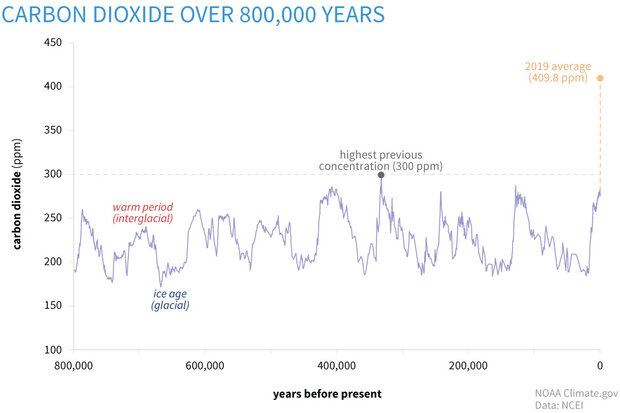Climate Skeptic Part 2: Is Climate Change Human Caused?
Part 2 of 7 – Continued from Part 1
Authors: Amber Bieg, Deb LaSalle, Zach Bell, Heather Colwell, Kevin Winslow, Jay Schuyler, Alaina Sisco, Mitch Samson
Is Climate Change Human-Caused?
Some skeptics believe that natural causes can explain why the Earth has warmed 1.4 degrees Celsius since 1880. Some point to Milankovitch Cycles (Earth’s orbital changes), our sun’s temperature variations, and volcanic activity to understand long-term climate trends, including ice ages and glacial/warming cycles.
The Earth does wobble on its axis; its tilt and orbit change over thousands of years which naturally pushes our climate into and out of ice ages. Historic ice core samples do show CO2 ranges fluctuating with M (Milankovitch) cycle-driven climate changes. However, M cycles operate for tens of thousands of years, while our current rapid warming is on a scale of decades. These cycles cannot explain the current rapid warming and changes to our climate. The current M cycle also does not support increased solar radiation theory either; instead, it demonstrates a period of warming caused by increased amounts of CO2 due to human activity. The overwhelming majority of scientists agree that natural causes of climate change do not account for the recent and significant temperature increases we’ve seen.
It’s important to note that the normal variances in climate, as described above, have always been relatively gradual, with global temperature changes occurring over thousands of years. When global warming has naturally occurred at various times throughout the past two million years, it has taken the planet at least 1,000 years to warm 1 degrees Celsius. The current rate of climate change on Earth is unprecedented. Some models predict the Earth will warm 2-6 degrees Celsius in the next century. This predicted rate of warming for the next century is at least 20 times faster than any historic or natural rate.[4] Without cutbacks in human-generated GHG emissions, temperatures will only continue to rise and rise more rapidly over time.

The dramatic increase of atmospheric carbon dioxide from 800,000 years ago to the present (as seen in the chart below and exhibited by the amplified spike to the right) shows this is not a natural cycle. When comparing natural cycles to the current amount of CO2, it is evident that something is drastically different.[5]
We can see that post-Industrial Age levels of CO2 have far exceeded historic levels.[6] Fossil fuel burning is not a natural process. We can easily measure how much fossil fuel is converted to CO2 each year and thus emitted into the atmosphere. The amount of carbon increase can also be measured in our reservoirs (including our oceans), in photosynthesis, and in the atmosphere. Approximately 57 percent of these emissions have remained trapped in our atmosphere.[7]
Human industry emits roughly 100 times more CO2 than volcanic eruptions. In addition, atmospheric CO2 levels, which are the major contributors to GHG emissions, are 40 percent higher than they were in the 1750s. When taking into consideration all possible natural and human-led causes of climate change, it’s clear that GHG emissions follow the trend lines shown by documented temperature increases.[8] To learn more about the real causes of climate change, see these videos which help illustrate the historic data for possible causes of GHG emissions.
Human activity related to agriculture, the use of refrigerants, and the burning of fossil fuels are causally linked to the current climate change trend we’re experiencing. The evidence points to the high probability that humans are causing climate change at a catastrophic rate.
But really, who is this catastrophic for? Cockroaches and rats will probably do fine. Many other species also will be fine. The planet has been around for several billion years, and life will likely continue on for the next few billion years. The problem is – or at least the problem we most care about is – that humans will suffer, and human civilization will not weather these events well. Based on the latest report by the Intergovernmental Panel on Climate Change (IPCC), if we want to see civilization thrive beyond the next 100 years, we need to mitigate climate change now.[9]
References
[4] NASA Earth Observatory. How is Today’s Warming Different from the Past?
[5] NOAA. Global Monitoring Laboratory. Trends in Atmospheric Carbon Dioxide
[6] NASA. Global Climate Change. Why Milankovitch (Orbital) Cycles Can’t Explain Earth’s Current Warming. Feb. 27, 2020
[7] UC San Diego. The Keeling Curve. Is the Current Rise in CO2 Definitely Caused by Human Activities? Sept. 19, 2018
[8] Bloomberg Businessweek. What’s Really Warming the World? June 24, 2015
[9] Intergovernmental Panel on Climate Change. AR6 Climate Change 2021. The Physical Science Basis. Aug. 7, 2021
